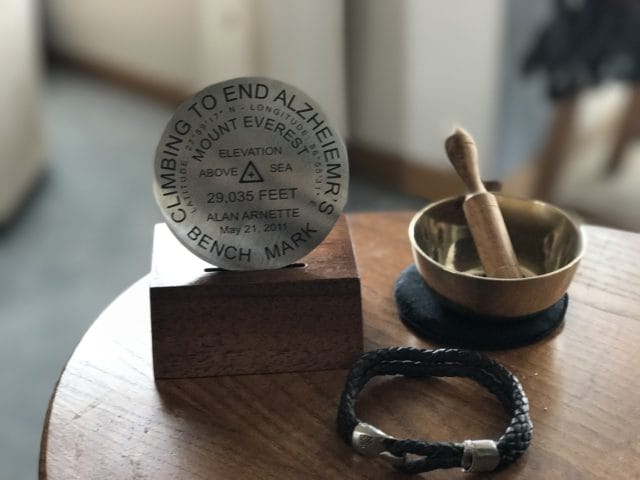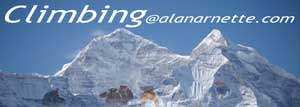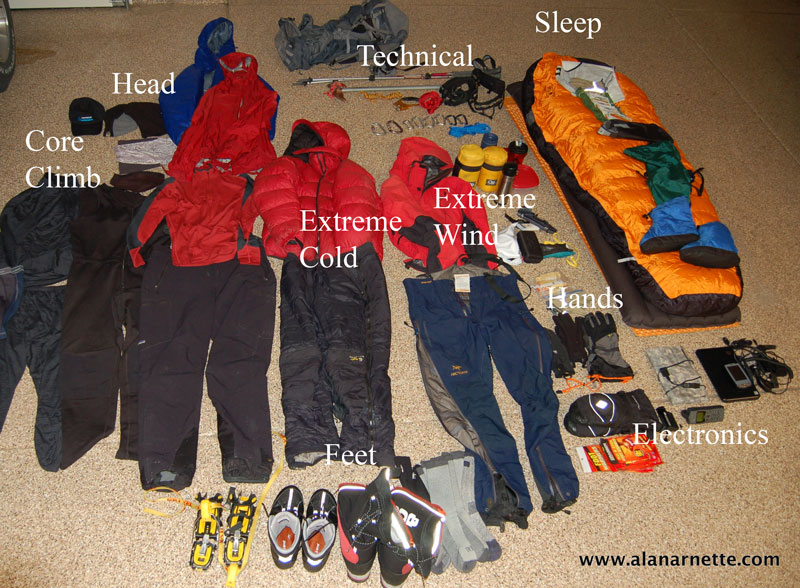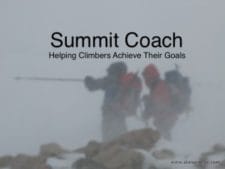Follow Virtual Everest 2020 – Support the Climbing Sherpas
starting April 2, 2020
Early March is an awkward time for aspiring Everest climbers. It is too late to make serious advancements in physical training and too early to eat what you want, assuming you will lose weight during the climb. Making serious gear changes is not advised nor is changing guide services. But there is still work to do!
Other than persistent rumors, and maybe a last-minute rule change from Nepal or China, Not much will happen for the next few weeks as climbers are en route. Once they arrive in their gateway city, they meet their teams, take care of a few details then begin the journey to their base camps.
Climbing will start around 15 April on the Nepal side and a few days to a week later on the Tibet side. If I were going this year, this would be my last-minute checklist:
- Review gear list
- Buy snacks
- Buy ebooks or reading material
- Buy summit socks
- Keep training
- Do not gain a lot of weight. Go in at your ideal weight
- Do not get hurt or sick
- Get your flu shot
- Familiarize yourself with the Cornaovius precautions
- Leave nothing left unsaid
For What It’s Worth
I will be home this year covering the action from Colorado, but there with the climbers in spirit. These are a few other last-minute thoughts for our Everest climbers.
Slow Down!
Don’t get hurt! While it may be tempting to add extra weight to the bar when doing curls or push that long run the extra mile – don’t. You are at diminishing returns.
Your body is about as good as it’s going to be. Twisting an ankle or pulling a muscle that takes six weeks to heal will sabotage your entire climb, plus undermine your confidence. Keep working out but move into maintenance mode where you tone, not build.
Don’t be antisocial, but avoid those people with colds or the flu. Replace handshakes with fist bumps and let Purill be your friend! Do not go to Nepal already sick! This is especially critical with COVID19 lurking out there.
You are what you Eat!
Watch what you eat; again this is not the time to get sloppy. Watch your balance of carbs, proteins, and fat. When in doubt, avoid the carbs because healthy fats and protein build muscles. You will lose weight even on the trek in, let it happen naturally. Your diet will take a considerable shift as you eat the food of the Khumbu or Tibet – lots of carbs through rice, little meat. Ask your logistics provider to add as much protein as possible to their meal plans – eggs, almonds, chicken, oats, lean beef, tuna.
Oh, and now is the time to knock off the booze. You should have already, but it adds empty calories that will not help you at 26,000 feet! Also, watch those beers on the trek in; one is enough with a meal, if any at all. After you summit, you can celebrate but not before.
Celebrate!
Speaking of reaching the summit, that is knowing you will summit 🙂 🙂 think ahead on how to honor your summit and time in Nepal. Many people bring family pictures or tokens that are meaningful to them. While not allowed and discouraged, many summiters leave something on the summit.
This is a picture of a small singing bowl that reminds me of the monasteries, the bracelet from Bravelets is what I wear to honor my mom, Ida Arnette, who died from Alzheimer’s and the medallion is from Mountain Monkey Company and can be customized for your summit.

Know What You Don’t Know
A few years ago, I posted what I tongue-in-cheek called a “personal letter” to 2017 Everest climbers with the message – don’t go! The main point I was making was that in modern times, post-2000, lack of experience played a large role in the deaths of some climbers. As we saw in 2019 with 11 deaths, lack of experience with both members and “guides” played a large role as I described in the 2019 Season Wrap-Up post.
But in the personal letter post, I went as far as to list some questions that were designed to make people think about what they thought they knew about climbing Everest. Shortly after that post, I received a comment asking for my view on the answers to those questions so here goes. Of course, these are my opinion as every question in this world has multiple answers these days. These were the questions for aspiring Everest climbers and my views.
Q: What is the highest altitude you have ever reached?
Alan’s view: I strongly believe that an Everest aspirant should have reached 8,000-meters before attempting Everest. You need to know how your body reacts at extreme altitude, and even then it’s not predictable. But the more experience you have, the fewer factors are left to chance. If you get a familiar sick feeling on the summit push or before, you know its time to turn back. But most operators don’t use this criterion and accept Denali and Aconcagua as their requirements. Others have no requirements and will gladly accept your money. Therin lies one of the major problems on 8,000-meter peaks today.
Q: When do you use a tent parachute stake on Everest? (trick question!)
Alan’s view: rarely if ever. A parachute stake is used in deep, soft snow, such as is usually found on Denali. Everest usually has hard-packed ice, so stakes are used.
 Q: What do you use to replace a lost jumar at the Balcony?
Q: What do you use to replace a lost jumar at the Balcony?
Alan’s view: bring a spare, or you can rig a system using a tribloc and carabiners or the Wild Country Ropeman 2 Ascender. Practice at home on how to use these devices.
Q: How long will a 4-liter cylinder of oxygen running at 2 liters per minute (lpm) or 4 lpm last?
Alan’s view: Climbers usually run the flow at 2 or 3 liters per minute, meaning a 3-liter bottle will last about 6 hours, 3 hours at 4 lpm. Most climbers will need at least 4 bottles or maybe 19 hours of supplemental oxygen because sometime they will run the flow at 3 or 4 lpm.
Q Is it ever acceptable to turn your oxygen down or even off while climbing Everest, especially near the summit?
Alan’s view: sure, it is advised to save Os since you need it when you are moving. If stuck in a long queue or line, turning it down to 1 lpm or even 0.5 lpm saves a lot of Os that may be needed later – especially if you have been stuck for a couple of hours. BUT – this should be a joint decision with your guide and Sherpa and not done without informing them.
Q: How long do you wait after a significant snowstorm to begin climbing again?
Alan’s view: the rule of thumb is to give a large load of new snow a minimum of 24 hours with a bright sunny day to settle to lessen avalanche chances – 48 is better. In general, on the standard routes on Everest, there have been few avalanches on the route itself. There have been avalanches off the adjacent slopes, Everest West Shoulder and Nuptse, that have killed many people.
Q: Will eating the same food as Sherpas increase your chances of summiting?
Alan’s view: Climbers need to eat what they can digest, and this should have been determined on other high altitude climbs, not for the first time on Everest. The staple of a Sherpa’s diet is Dal Bhat, white rice accompanied by curried vegetables and a bowl of a lentil-based juice. Many westerners love it, but it can get boring after a few days for some. Also, it has a small amount of protein that I find is critical to avoid losing weight. Before leaving camp in the early morning, the Sherpas will eat a filling meal called tsampa, which has a porridge-like consistency and is made from roasted barley flour mixed with tea, beer, or water and formed into thick dough-like balls. I have found that few westerners can eat like a Sherpa at 3:00 AM! Most will eat eggs and toast before heading up the mountain.
Q: How do you keep your hands warm if you lose a glove at 7500 meters?
Alan’s view: bring a spare set of gloves and mittens plus chemical hand warmers. Bare skin can freeze in minutes at those altitudes with harsh winds and freezing temperatures.
Q: How much larger or smaller should your mountaineering boot be compared to your street shoe size? (another trick question)
Alan’s view: The rule of thumb is to buy your high altitude boots at least one size larger than your street size. Feet swell at altitude – a critical point. But the best technique is to buy your boots from a local store, not online, and try them on with the exact sock configuration (thick, thin, combinations) you will use on Everest. Then wear them on a local hike – at home – and go back to your expert store for any adjustments, such as widening the toe box. If you don’t have a local store that sells high altitude boots, then buy from an online store where you can exchange wrong sizes easily.
True/False: Having a SPOT or InReach with the SOS feature will ensure that a rescue team will reach you in case of a crisis anywhere in Nepal.
Alan’s view: While this is a comforting selling point for those at home, the reality is those devices are monitored by organizations halfway across the globe. Yes, they may be able to contact your rescue service (Global Rescue, Travelex, etc.). Still, in the end, you will be rescued by someone within hours of you, not across the world, so a reliable multichannel radio that you know how to use and are 100% certain that the frequency you use is monitored serves as your best protection. Better yet climb with someone you trust and has the skills to help in case of an emergency, this most likely means going with a proven, experienced guide service. Also, note that most “insurance/rescue companies” do not perform searches. That is left to your guide company.
True/False: Sleeping in an altitude tent replaces the need to do acclimatization rotations.
Alan’s view: The conventional wisdom is that altitude tents will acclimatize you to about 17,000 feet. Everest is 29,035 feet so you will still need to do acclimatization rotations but maybe not as many. But everyone reacts differently to these situations, so arriving late or buying your return plane ticket based on “pre-acclimatizing” is ambitious – IMHO.
True/False: Acclimatizing on smaller nearby peaks substitutes the need to sleep at high altitudes on Everest before making your summit bid.
Alan’s view: It is common these days to use the 20,000-foot trekking peak Lobuche as an acclimatization peak to eliminate one or maybe two rotations through the Khumbu Icefall. But even with this strategy, teams usually try to get to 21,000 feet or 23,000 feet before the summit bid on either side.
True/False: Anyone in ‘good shape’ can summit Everest without much difficulty.
Alan’s view: This is a fashionable marketing statement but is naive and dangerous, in my humble opinion. The altitude on Everest is what makes it so dangerous. Being in the best shape of your life is probably not Everest shape, and altitude sickness can strike anyone at any time – even those long time professional climbers who have never gotten altitude-related illnesses before. So, yes, being in great shape is necessary but not sufficient to climb Everest. And no-one, no-one, summits Mt. Everest without some discomfort – even Sherpas.
True/False: Being so tired that you can barely move is normal on Everest or at any extreme altitude.
Alan’s view: Reaching a high level of fatigue is quite common. This is why having experience on a previous 8000m climb is critical to understand if you are just hurting or really hurt. But if someone is so fatigued that they cannot move without assistance, it is a clear sign to descend immediately on a high flow of supplemental oxygen – with aid from healthy climbers. Never climb alone on Everest or any high altitude mountain.
True/False: Summiting Kilimanjaro, Mont Blanc, Island Peak, Lungser Kangri, or Mentok 2 will adequately prepare me for Everest.
Alan’s view: These peaks will give someone a lot of mountaineering experience but are not sufficient to attempt Everest, again, in my humble opinion. I firmly believe you need to have a personal experience above 26,246 feet or 8,000 meters to understand how your body reacts at that altitude. Some people simply shut down and cannot function; others do well; everyone struggles to some extent. Those peaks listed in the question will help you understand some basics of climbing on high, somewhat steep mountains but are in a different league than an 8,000-meter climb.
and finally
True/False: There is no safety difference between climbing with a service that charges $30,000 and one that costs $60,000 as long as you have a Sherpa with you that has summited before.
Alan’s view: In 2020, that are several companies that will take on an Everest climber for under $35,000, and there are real differences including safety. I terms of Sherpa experience – some have never climbed Everest so just because the last name is Sherpa, does not make them qualified to help you on the Hillary Step. Also consider, radio communications, amount of supplemental oxygen, quality of and sufficient food to maintain a healthy weight, group gear such as tents, stoves, and fuel at high altitude, etc. The more you pay, with exceptions, the more support you will have from qualified Sherpas and/or western guides, spare equipment, and oxygen resources to assist in case of an emergency and experience on the mountain. All for this cost real money. Research your guide service and get recent references from a climber who has a similar profile to yours (age, experience, etc.) before sending in your money.
OK, so those are my views, and I sure others can add or disagree. All good!
Summit Coach
Are you planning a big climb in the next year from Aconcagua to Manaslu or even Everest in 2021? I can help.
Summit Coach is a consulting service that helps aspiring climbers throughout the world achieve their goals through a personalized set of consulting services based on Alan Arnette’s 25 years of high altitude mountain experience and 30 years as a business executive.
The Best Advice
A longtime reader and climber preparing for Everest sent me this question last week: How do you keep sleeping and keep mental focus 20 days before leaving for Everest without stressing yourself out?
My answer was:
Focus on “leaving nothing unsaid” with those who matter most in your life. Visualize being on the mountain with a positive outcome. Review your gear continuously using a mental walk-thru of the climb to make sure you have everything you need and want. Finally, surround yourself with positive people who have fun, laugh, and support you.
And a bit more on this.
Family Meeting
Now is the time to have a family talk about your climb. Get everyone together in the same room and talk openly about the schedule, what to expect, when you will call, or send an email. Set expectations, so you minimize surprises. And remember to tell everyone that no news is not bad news, it is just no news.
Make sure that everyone knows Everest Base camp is remote, and communications are spotty, regardless of what they may read. If voice to voice live communications is vital to you, buy or rent a Thuraya or Iridium satellite phone. It is the only method you can 100% count on from anywhere on the mountain. Yes, it is expensive, but hearing your loved one’s voice after a disaster like an avalanche or earthquake is beyond measure. Also, consider the Garmin InReach. It supports two-way text messaging and works anywhere an Iridium satphone would. It has become a must-have for most international climbers.
If you have parents that live far away, take time to call them, listen carefully to their fears. Talk them through everything. Of all people, they most likely don’t understand why you are climbing. This is not the time to argue, and it is the time to listen and tell them that you understand that they don’t understand and that you love them.
Have the Talk
But this is the essential emotional step of all. Have a conversation with the one person in your life that matters the most to you. Be open, candid, honest. Tell them how you feel. Share with them your dreams, your hopes. Listen carefully as they tell you their fears, which will keep them up at night.
While you may be on the mountain, they are climbing with you each step of the way back home. You have the advantage of knowing what is going on, they can only guess, and sometimes they will guess wrong. Often there are no answers to these fears, these dreams, but talking about them together will help you feel closer when you are lying in the tent at Camp 4, with the wind howling and the temperature dropping. You will remember that conversation forever.
Surprise your climber and your loved one with a short video message left on their phone that they can watch before heading toward the top of the world. Your confidence and energy will touch them in ways you never imagined.
And for those left at home, they will draw on that conversation as they struggle to go to bed on your summit night. It might have been days since they last heard for you, and this conversation will be the strength from which they draw, the comfort as they replay your voice in their mind.
2020 Outlook
Unknowns
As I reported last week, officials tell me they expect the number of climbers to be cut in half on both sides. Nepal issued 382 permits in 2019, but for 2020 less than 250 are now expected. And only 50 on the Tibet side. This does not include support which is about the same as the number of permits issued. Many Chinese climbers plus those from Japan and Korea have already canceled their climbs on the Nepal side. I’m told several operators are switching from Tibet to the Nepal side, and a few are considering canceling altogether. There were 876 total summits by all climbers and support on all routes in 2019, and I expect about half that for 2020.
We can expect a lot of spin from Nepal Government, officials and even guides not wanting to see last-minute cancellations. The truth is nobody knows what to expect so if you are going, be prepared for any scenario. Check with your insurance company as to the specific level of coverage. And if you get sick, get home ASAP – don’t stay in Nepal for China – if the airline will let you.
Finally, the New York Times reported that any Nepal “new rules” will not be applied to the 2020 season quoting:
Kedar Bahadur Adhikari, the secretary of Nepal’s tourism ministry, said the rules, which were introduced last August, had yet to receive approvals from several government offices, including the defense, law, finance and forest ministries.
This was expected, as the Nepal mountaineering officials have a history of talking big with zero action. The article also suggests record permits, over 400, contradicting what I was told last week by a top official citing Chinese, Japanese and Korean cancellations. We will see soon who shows up. But it’s clear that the spin-machine is on to save the revenue.
Himalayan Database
Another reminder that I use the Himalayan Database as my primary source of Everest summit statics. If you are climbing in 2020, they are asking you to fill in an electronic web-based survey. This replaces the time-consuming process of visiting each team in their hotel before the climb. Please use this link to complete the survey. You can now download the HDB for free at their site.
Follow Along!
I have begun to create my annual team location table and tracking climber’s blogs (see sidebar). If you have a team not listed, please let me know, and I will add them if I can track them. If you prefer not to be mentioned, please contact me. I will post a few background articles and interviews between now and early April when the teams arrive at the base camps. If you would like to see anything special this year, post a comment or drop me an email.
Here’s to a safe season for everyone on the Big Hill.
Climb On!
Alan
Memories are Everything




